Flowering Hedge Plants: 10 of the Best Bushes For Hedges
Whether you're trying to grow a privacy screen or just need something to separate your yard from the sidewalk, a hedge is a great idea. These flowering hedge plants will add some color and beauty to your garden.
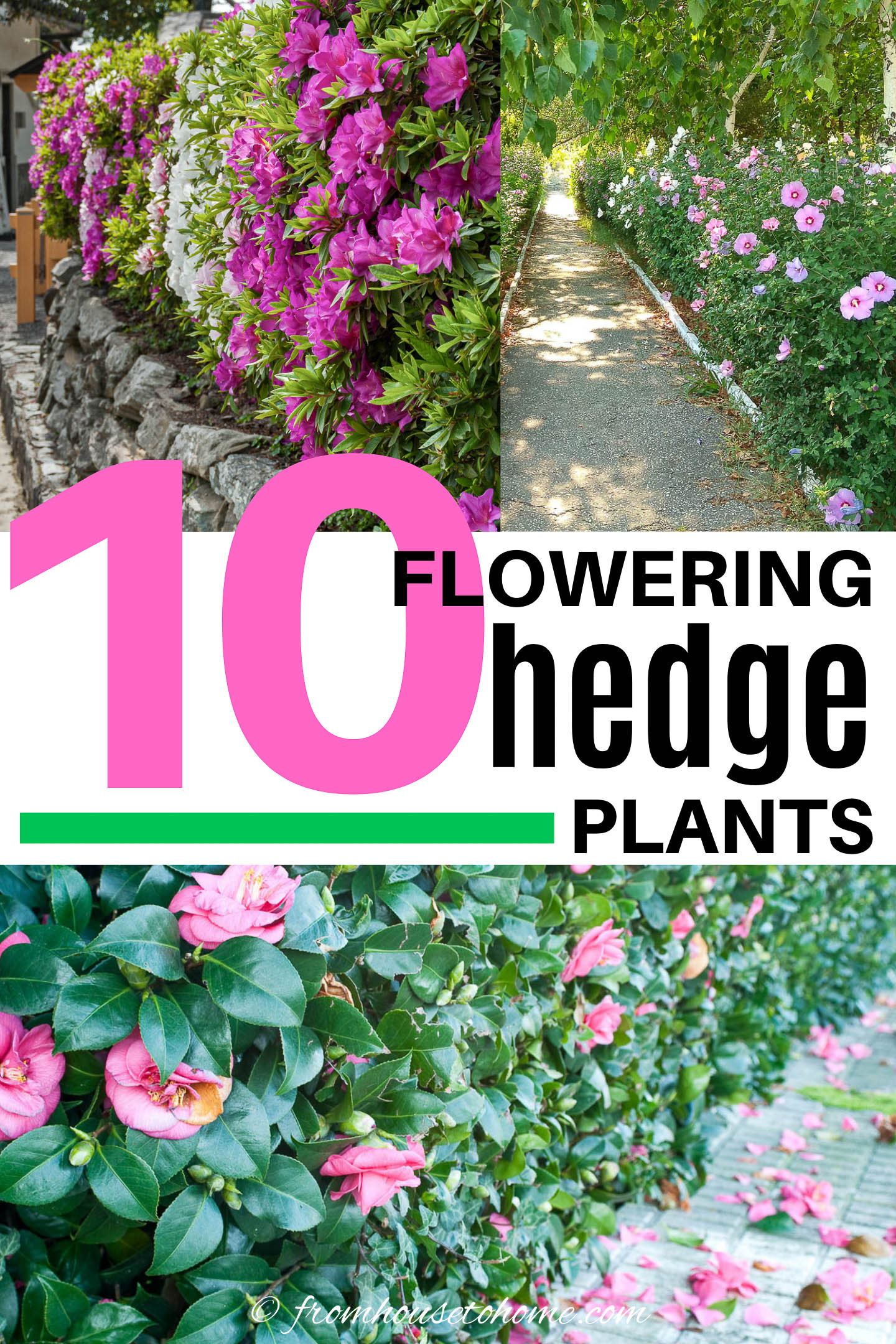
Are you thinking of planting a hedge?
Whether you need some privacy in your garden, or just want to create some separation between your yard and the sidewalk, shrubs are a great way to do that.
But why settle for the faithful and commonly-used evergreens (like cedar or Thuja), when you could have a row of bushes that is covered in flowers?
You can have fragrant seasonal blooms that attract bees, butterflies and hummingbirds. Or plant something that blooms all summer.
How to choose hedge plants
But before we start looking at plants, there are a few things you need to know so you can decide what type of hedge to get.
Your preferences
First is what you would like your hedge to look like and how much work you are willing to do:
- Do you want a bold wow factor or a classic beauty?
- Do you like hedges that are trimmed and tidy? Or something a little more natural looking?
- How high would you like it to be?
- How much maintenance are you willing to do?
- Would you like an evergreen hedge or are deciduous bushes okay?
Growing conditions
Another thing to consider when you are thinking of planting a blooming hedge, is your site.
- Does it have lots of sun, or is partial shade more prevalent?
- What zone do you live in?
- What type of soil do you have? Clay or sand? What is the soil pH?
- How much moisture does it have?
You'll need to choose plants that will thrive in those conditions. For example, you would not likely have success with hydrangeas planted in an area that gets no water.
How much space you have
Now measure the length and width of the planting area.
You will want to calculate how many plants you need based on their mature width center to center.
If you prefer a dense hedge, then plan to plant them at the narrower end of the recommended range.
And try to find shrubs that are not too wide for the space you are filling.
Otherwise, you will constantly be pruning the bushes to keep them from overtaking the sidewalk. Which not only is a lot of work, but will likely limit the number of blooms you will get.
Now let's get on with the shrubs that will make a great flowering hedge.
1 | Camellia hedge
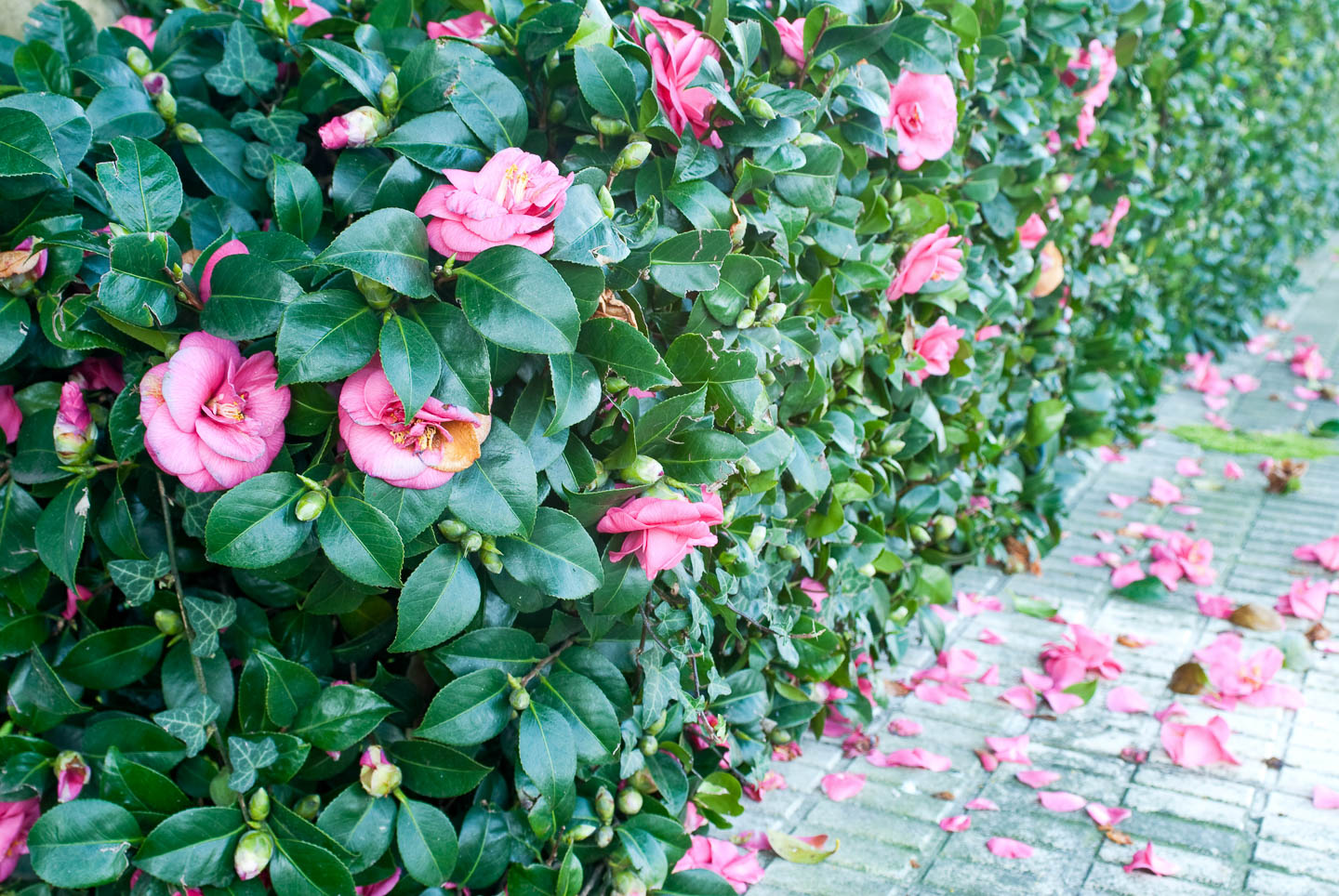
Zone: 6 to 10
Exposure: part shade to shade
Height: 8′ to 20′
Width: up to 20′
Bloom time: fall, winter, spring (depending on the variety)
Bloom color: red, white, pink
Camellia is one of the few flowering hedge plants that will bloom in the winter.
It is also evergreen and tall so it makes a perfect privacy screen.
Plant camellias in compost enriched, acidic, well-drained soil and mulch to retain moisture.
Water regularly with a drip system the first year.
After that, camellias are drought tolerant. However, they do best out of the wind and in part shade.
To keep a Camellia hedge the size you want it, prune after it has finished blooming using very sharp, clean sequiturs. Don't wait too long after the flowers are done or you'll cut off next year's buds.
Learn more about growing Camellias.
2 | Rose of sharon
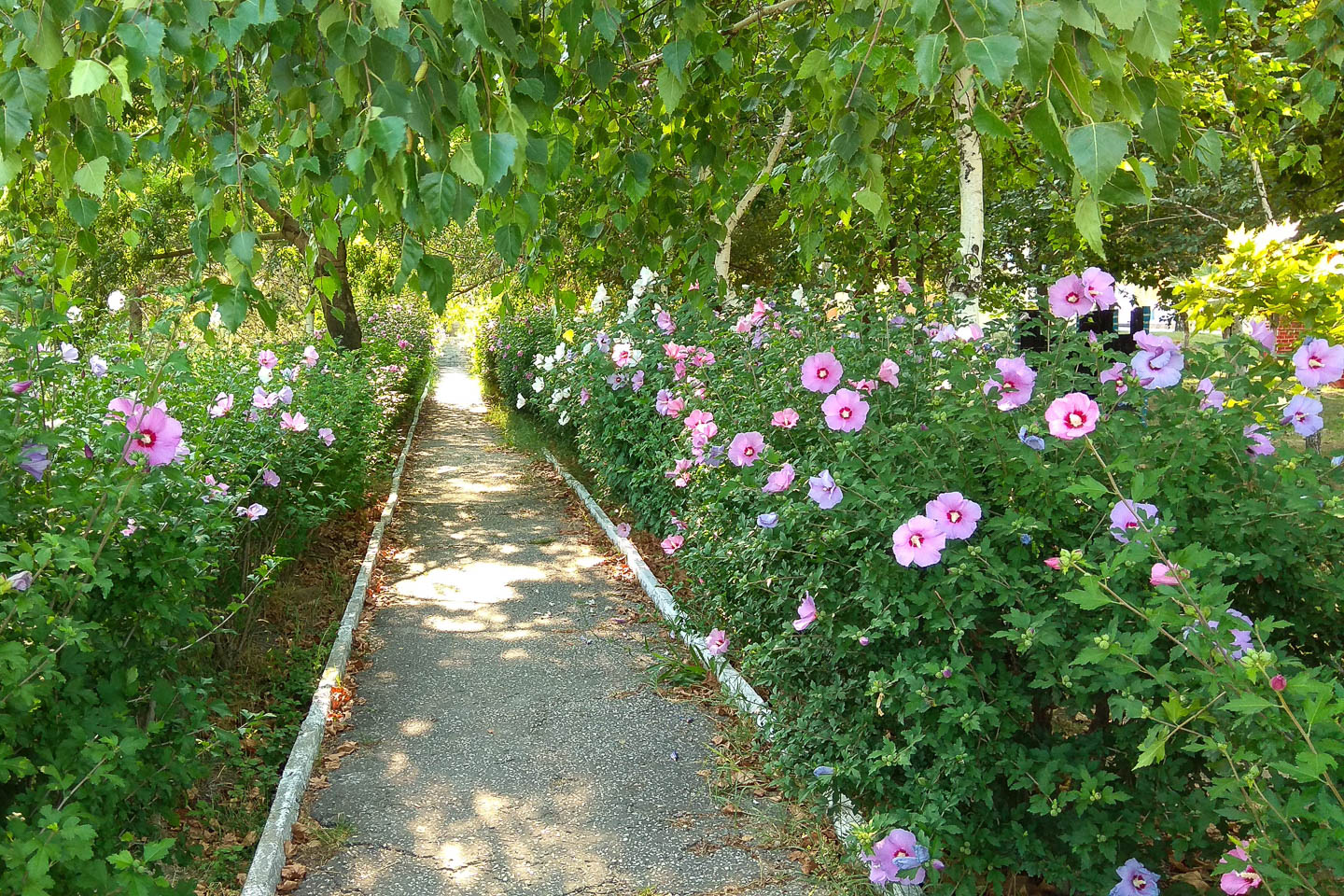
Rose of Sharon is a large shrub that is fairly fast growing and makes an excellent flowering hedge.
It blooms in the summer through fall. And since it's a member of the Hibiscus family, the flowers look quite tropical for a hardy bush.
It's also fairly deer resistant which is a bonus if you are growing the hedge to try to keep deer out of your garden.
Some Rose of Sharon shrubs tend to self-seed prolifically so if you want to keep your hedge low maintenance, try to avoid those varieties.
Purple Pillar® Rose of Sharon (Hibiscus syriacus)
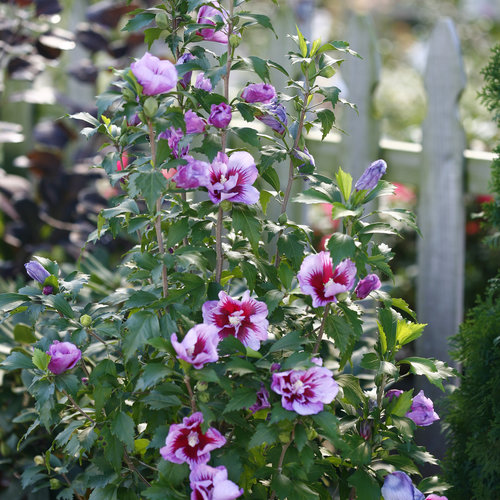
Zone: 5 to 9
Exposure: sun
Height: 10′ to 16′
Width: 2′ to 3′
Bloom time: summer through fall
Bloom color: white, purple
While all Rose of Sharon shrubs will make a good hedge, the Pillar® hibiscus is an innovative introduction that has revolutionized where they can be grown because it takes up so little space.
It has an unusual columnar shape that is great for a narrow privacy screen.
The semi-double flowers bloom all along the stems and attract pollinators.
Both heat and drought tolerant, the rose of Sharon is also low maintenance. It seldom needs pruning.
3 | Crapemyrtle

Crapemyrtle is a large bush or small tree with deciduous leaves and pretty multi-colored bark, which provides an interesting look even during the winter.
It isn't as dense as some of the other bushes on this list, but can still make a pretty hedge if separation rather than total privacy is your goal.
Center Stage® Crapemyrtle (Lagerstroemia indica)
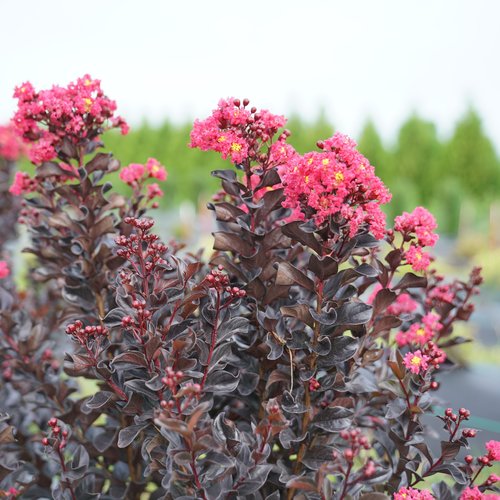
Zone: 6b to 10
Exposure: sun
Height: 6′ to 12′
Width: 8′
Bloom time: spring to fall
Bloom color: red or deep pink with yellow stamens
Center stage® Crapemyrtle is a narrower growing bush than the species, making it a good choice for smaller gardens.
It is more disease resistant and vigorous and has fantastic purple/black foliage.
This Crapemyrtle provides stunning 3 season interest in the landscape.
If you want a tall, long-blooming hedge that needs no pruning, it is a prime choice.
This shrub can be planted in any soil pH, and likes average water.
It attracts pollinators and birds, and repels deer.
4 | Azaleas (Rhododendron)
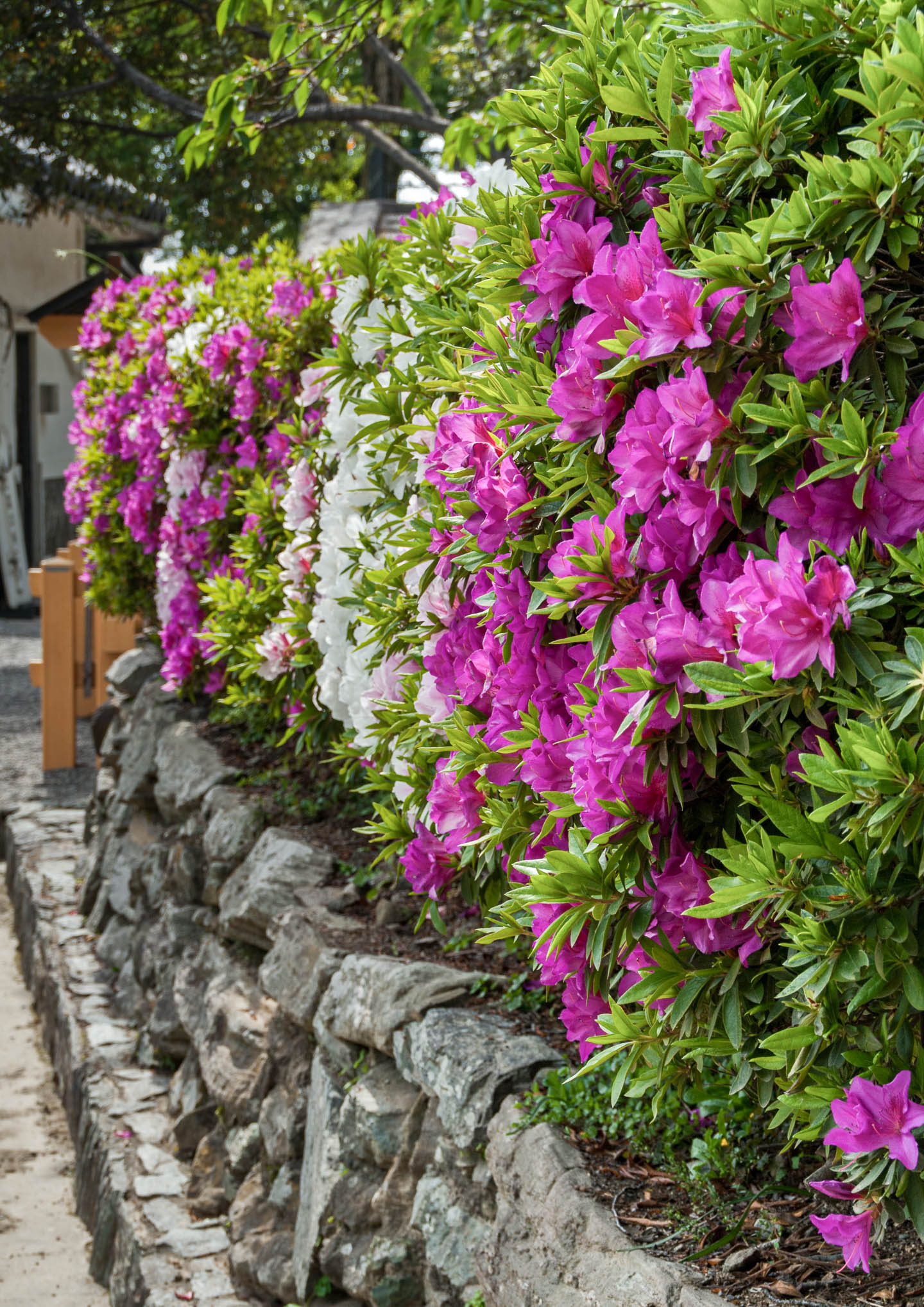
There are a few different types of Azaleas that make good hedges, including the North American native plant, Encore Azaleas and the smaller Asian varieties.
They do not need pruning to thrive, but if you want to cut them back, do it immediately after they have finished blooming. Otherwise, you may cut off next year's buds.
Note that some Azaleas (like the Northern Light series) have a looser habit which is not conducive to making a good hedge. So be sure to get one of the denser varieties.
Native Azalea
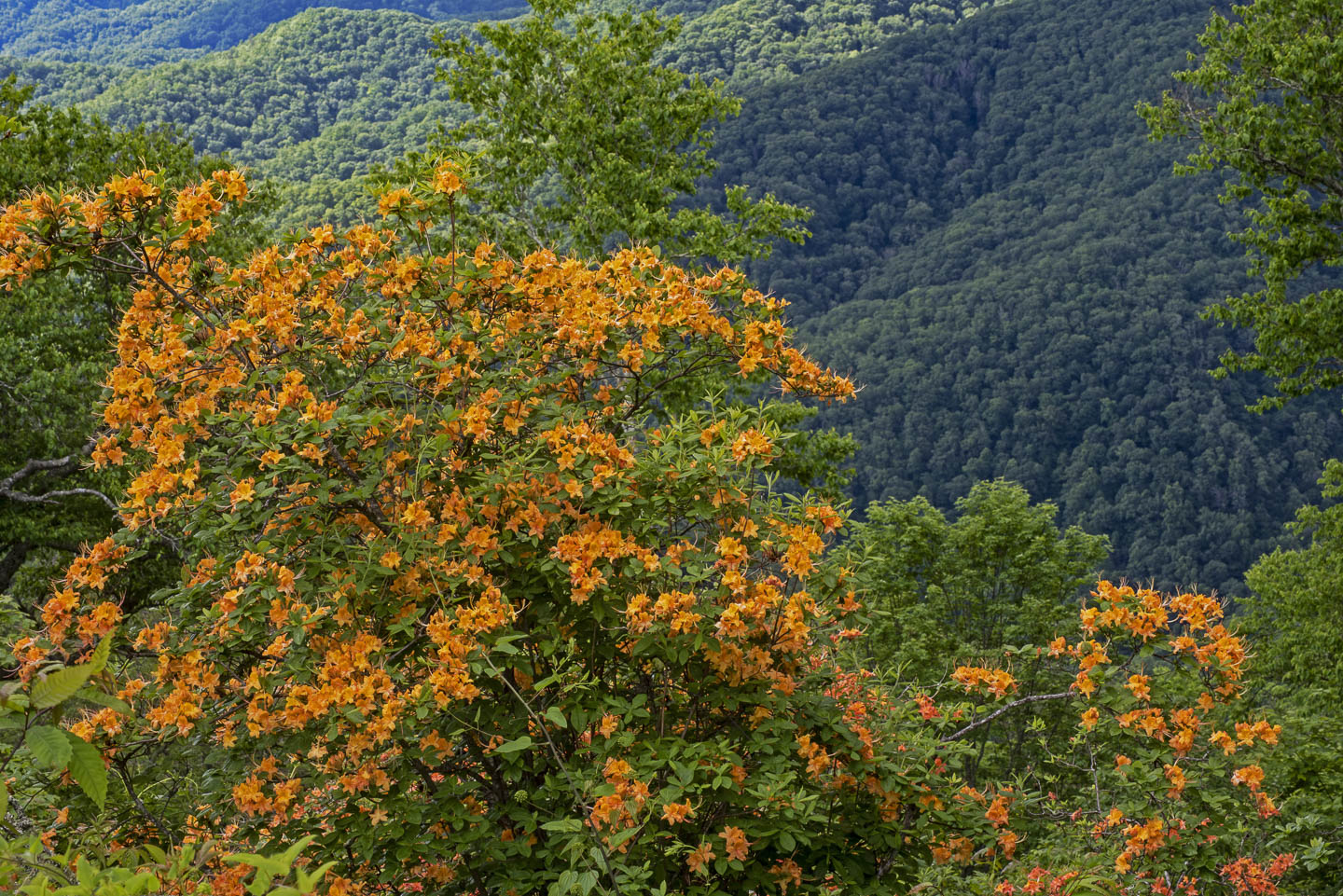
Zone: 6 to 8
Exposure: dappled shade
Height: 2′ to 15′ (for a hedge choose a variety that grows 6′ to 8′ tall)
Width: 6′ to 8′
Bloom time: spring to summer (depending on the variety)
Bloom color: white, pink, orange, salmon, yellow, red
The native azalea is a slow growing, deciduous shrub that produces flowers on the end of the branches.
And as you can see from the Orange Flame azalea growing wild in the Blue Ridge Mountains above, the blooms are prolific!
Many native azaleas also have leaves that turn yellow, red, or dark burgundy in the fall. Pinxter bloom azalea (R. periclymenoides) or Pinkshell azalea (Rhododendron vaseyi) are two such varieties that will provide three seasons of interest.
This shrub does well in acidic, woodland soil and needs lots of moisture. There is even a swamp variety (R. viscosum) if you have a spot with wet conditions.
Native azaleas should not be pruned extensively, except to remove broken or dead branches. Therefore, it is important to choose a species that will grow to the height and size you want.
Encore Azaleas

Zone: 6 to 10
Exposure: sun to part shade
Height: 2′ to 6′
Width: 2′ to 6′
Bloom time: spring to fall
Bloom color: white, pink, purple, red
For an evergreen hedge that is quite dense, Encore Azaleas are a good option.
They have been bred to re-bloom, producing a large show of flowers in the spring and then blooming sporadically through the rest of the growing season.
As with most Azaleas, this shrub does not need to be pruned, but if you would like to shape them, do it immediately after the spring blooms are finished so you don't remove any buds.
These bushes come in many different sizes so be sure to check the variety to make sure it fits your space.
Learn more about growing Azaleas.
5 | Bridal wreath spirea (Spiraea prunifolia)
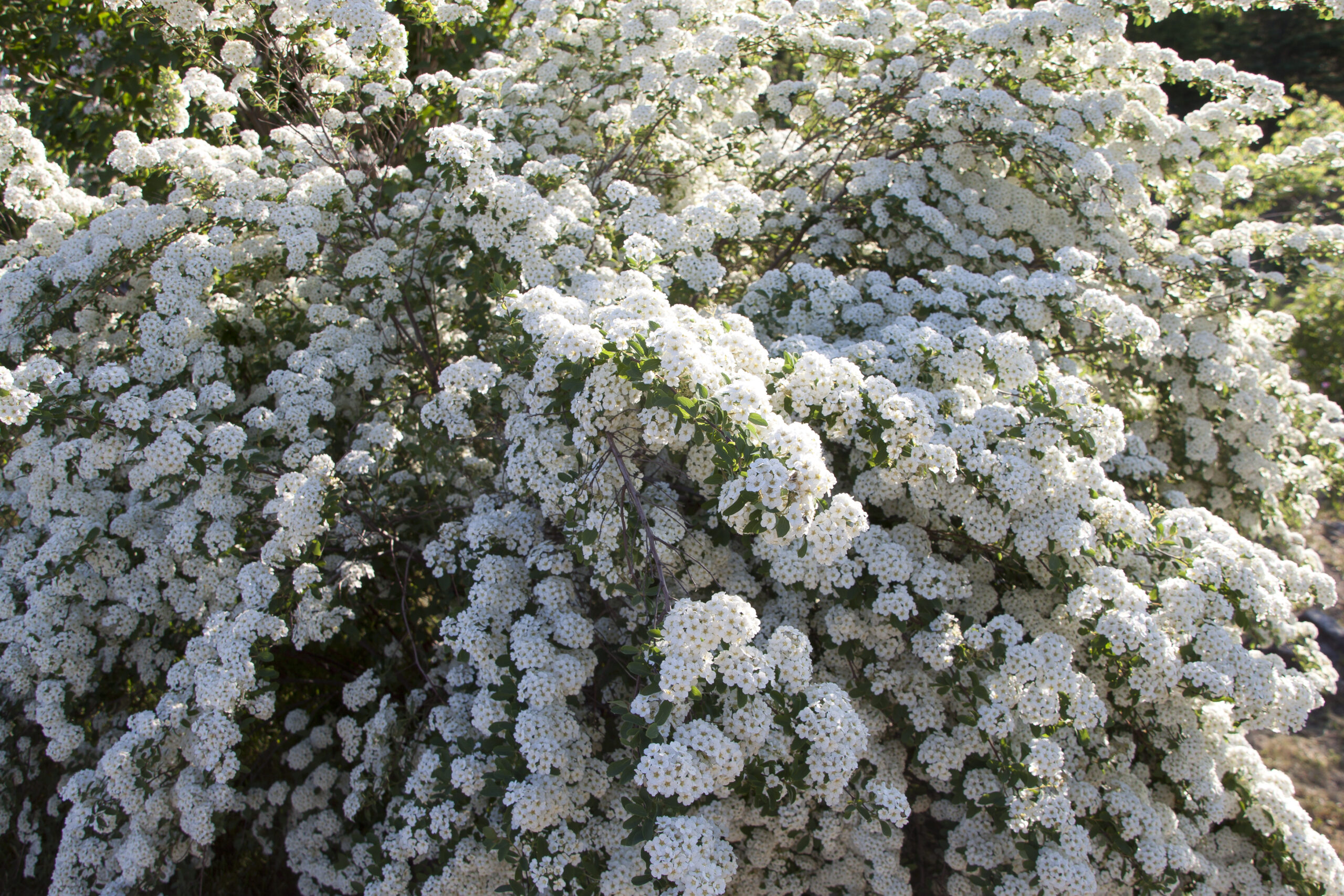
Zone: 5 to 9
Exposure: sun, part sun
Height: 6′ to 9′
Width: 8′
Bloom time: spring
Bloom color: white
Bridal wreath Spirea is a fairly wide shrub with white flowers that will need some room to expand, since you won't want to prune its arching branches.
There is nothing as majestic as the gorgeous white double blooms draping to the ground and covering the entire row of bushes. It has been described as ‘fountain-like' in shape.
If the shrub gets too leggy, it can be pruned immediately after it flowers.
The foliage turns brilliant orange-red in the fall.
Bridal wreath spirea is drought tolerant, and repels deer.
6 | Lilac hedge
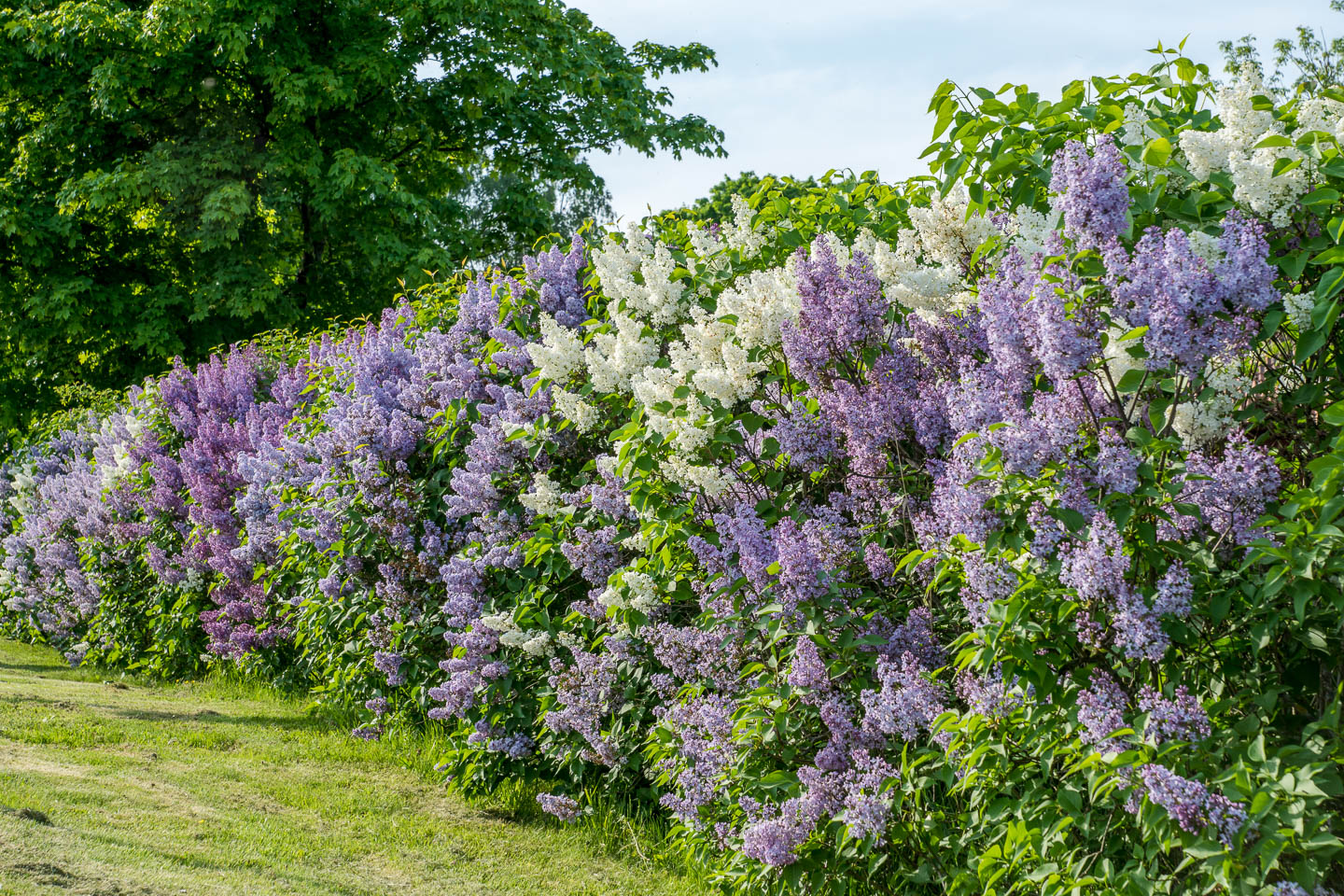
In my opinion, the only thing better than having one beautiful lilac bush blooming in the spring is to have a whole hedge of them!
Not only do they smell beautiful, their pretty blooms make great cut flowers.
And the bushes are quite low maintenance, which is always a bonus if you have a bunch of them.
Lilac Scentara Pura® (Syringa x hyacinthiflora)
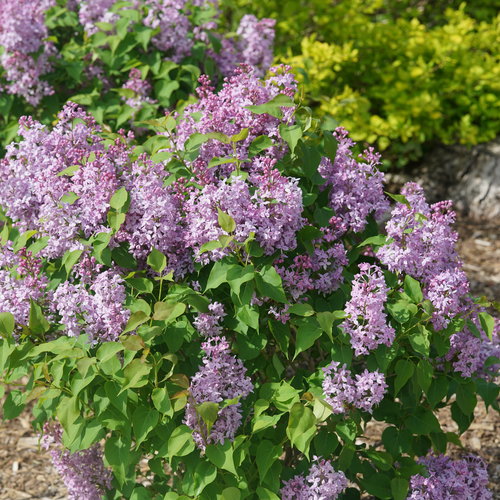
Zone: 2 to 8
Exposure: sun
Height: 4′ to 6′
Width: 4′ to 6′
Bloom time: spring
Bloom color: purple
As the name suggests, ‘scentara pura' lilac has a strong, pure, lilac scent and beautiful deep purple flowers.
It is disease resistant so the green foliage looks good even after the blooms have faded.
This lilac performs better than other lilacs in places that have mild winters.
Plant in well-drained soil. Do not amend the soil when planting. Prune spent flowers after they have finished blooming.
Learn more about growing lilacs.
7 | Hydrangea
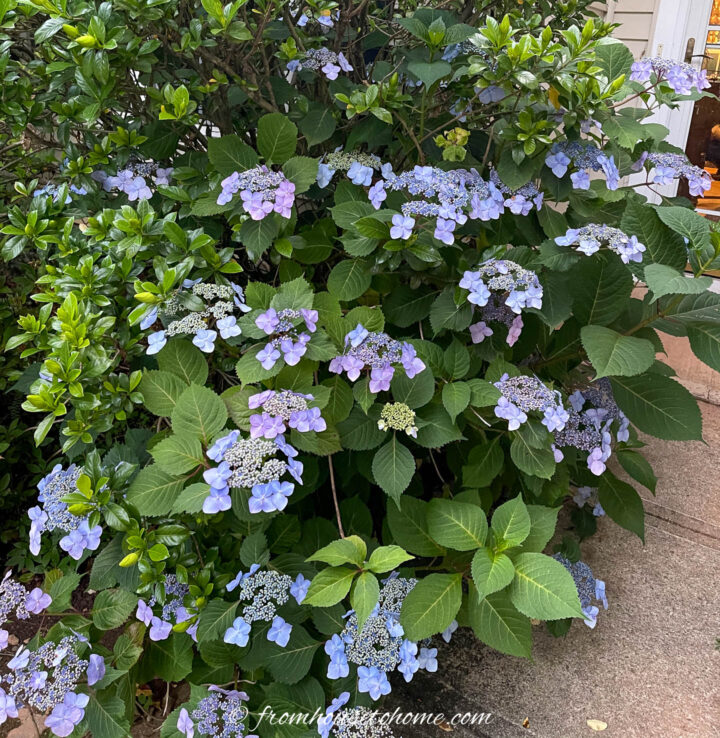
Hydrangeas are one of the most popular garden plants for a reason.
They have the most incredible blooms that last for most of the summer and make excellent cut flowers for bouquets, either fresh or dried.
There are many hydrangeas of various heights that would make good flowering hedge plants. This includes the Hydrangea macrophylla varieties that are commonly found in urban gardens (such as “Twist and Shout” above).
But if you want a bigger hedge that has more structure to it in the winter, then the two varieties listed below may be what you're looking for.
Panicle Hydrangea (Hydrangea paniculata)
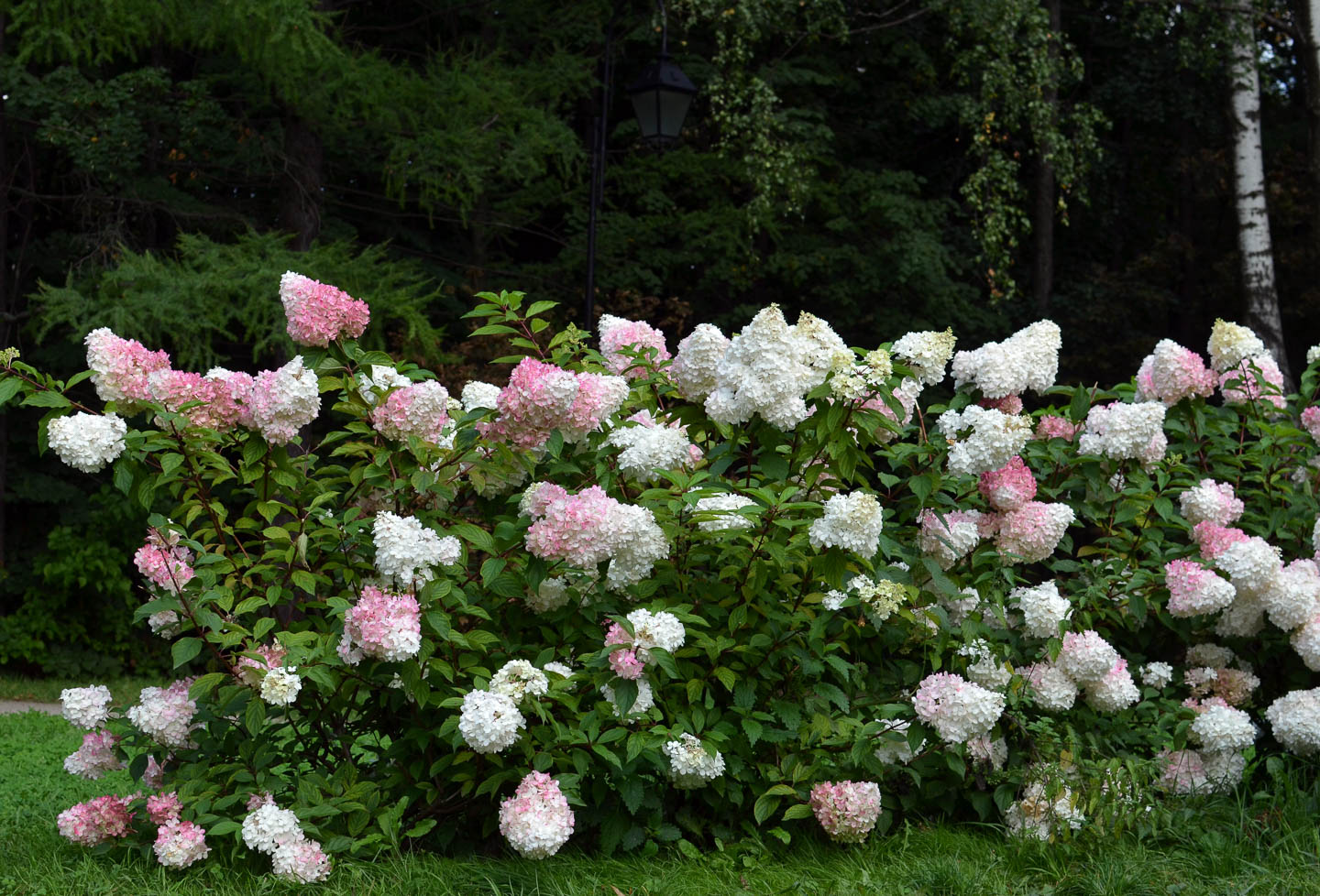
Zone: 3 to 8
Exposure: sun, part sun
Height: 4′ to 8′
Width: 4′ to 8′
Bloom time: summer to fall
Bloom color: white becoming pink/red
There are many hydrangeas of various heights that would make good hedges, but, if you want some bold wow factor, you can't beat .
Hydrangea paniculata bushes sport huge blooms that start out white and then turn either green or pink, depending on the variety.
Panicle hydrangeas should be planted in rich, well-drained soil, but are more drought tolerant than the macrophile types.
Cut back to 2 – 3 nodes from the ground in late winter. They bloom on new wood so you don't have to worry about cutting the buds off.
One of my favorite new varieties is Zinfin Doll. It has flowers that grow on strong stems and remain upright in the rain. They start out pure white then become pink from the bottom upwards, eventually turning a deep pink-red as temperatures cool.
Other full size panicle hydrangeas to consider are ‘Fire light,' ‘Pee gee,' ‘Quick fire,' ‘Limelight,' or ‘Pinky winky.'
Incrediball® Smooth Hydrangea (Hydrangea arborescens)
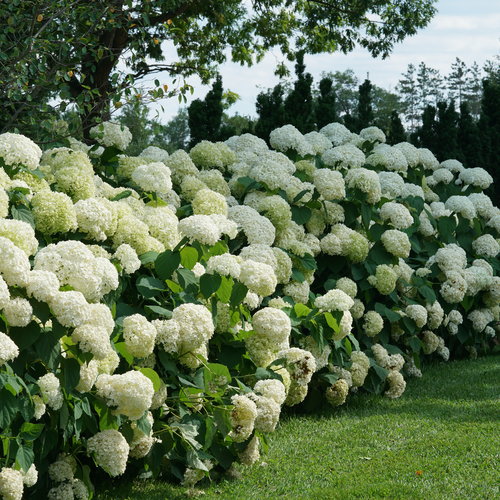
Zone: 3 to 8
Exposure: part shade to sun
Height: 4′ to 5′
Width: 4′ to 5′
Bloom time: summer to fall
Bloom color: white, pink
For an easy care, attractive, green hedge with huge, white (or pink) flowers, you may enjoy this native plant – Hydrangea aborescens.
‘Incrediball®‘ is an improvement on the old reliable, ‘Annabelle,' in that it has stronger stems to hold up larger blooms.
This bush needs rich, well-drained but consistently moist soil.
A layer of mulch is important to retain moisture.
It blooms on new wood so benefits from pruning back by 1/3 of its height in early spring.
However, it does not need dead-heading to bloom all summer and into the fall.
I leave the flowers (which turn beige after the first frost) on the plant over the winter for continued interest in the landscape.
Incredible hydrangea attracts bees and butterflies.
8 | Reblooming Weigela
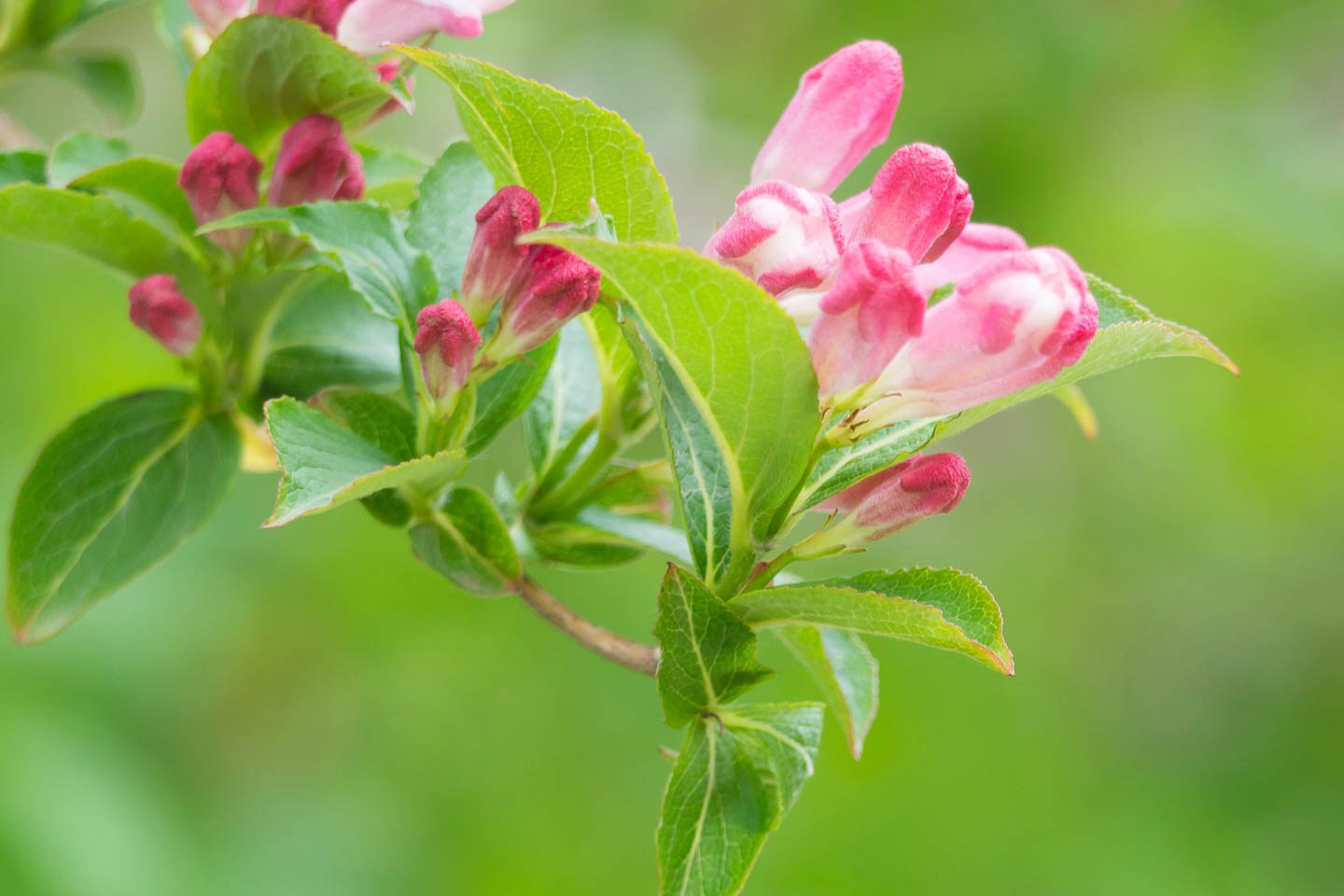
Weigela is a deciduous plant with green leaves and a mounding habit.
It is a low maintenance plant that will tolerate most soils as long as they are well-drained and makes a neat bright hedge along a fence line.
However, if you're going to have a flowering hedge, you may as well have one that blooms all season. So, rather than planting a standard spring-blooming variety, choose a reblooming one instead.
Sonic bloom pink® Weigela (Weigela Florida)
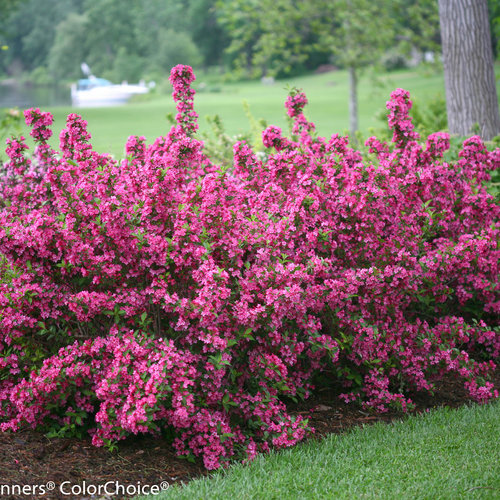
Zone: 4 to 8
Exposure: sun
Height: 4′ to 5′
Width: 4′ to 5′
Bloom time: late spring, late summer into fall
Bloom color: pink
Although sonic bloom weigela comes in red and pearl colors, the pink version is the best rebloomer.
It does not need deadheading to continuously bloom all summer after the big flowering show in May.
This bush attracts hummingbirds and repels deer.
9 | Landscape roses

Because of their beautiful flowers and long blooming season, roses are another of the most popular shrubs with gardeners.
However, not all roses make good flowering hedge plants.
Many of the hybrid tea varieties are susceptible to diseases if planted too close together, and don't spread out enough to create a hedge.
Which is why I recommend using landscape or shrub roses for this purpose.
Oso Easy Double Red® Rose
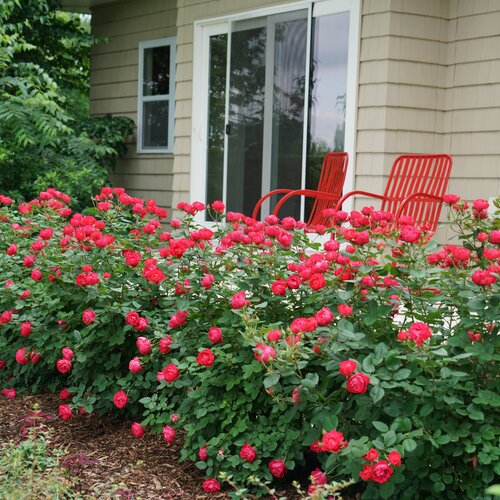
Zone: 4 to 9
Exposure: sun
Height: 3′ to 4′
Width: 3′ to 4′
Bloom time: summer
Bloom color: red
‘Double red' is a landscape rose that blooms all summer without deadheading.
The flowers have long stems that rise above mildew and black spot resistant, green foliage.
It prefers moist, well-drained soil and doesn't require heavy pruning.
You will want to pick yourself a bouquet of these beauties!
At Last® Rose
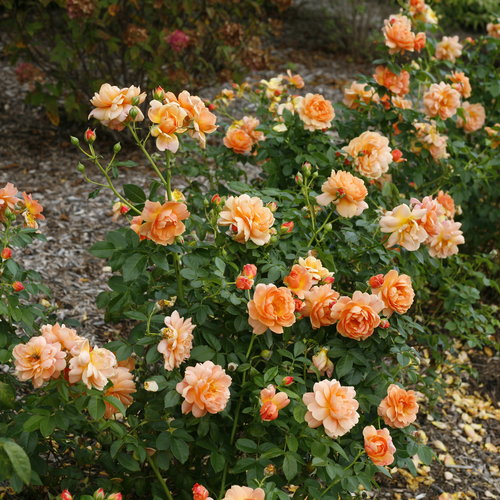
Zone: 5 to 9
Exposure: sun
Height: 30″ to 36″
Width: 30″ to 36″
Bloom time: spring through fall
Bloom color: peach
‘At last' is a real break-through for rose breeders.
It is one of the best hedge roses in that it has a long bloom time, is disease resistant and deadheading is not necessary to keep the plant blooming.
Its fragrant flowers look like tea roses and the lovely salmon color is contrasted beautifully by the shiny dark green foliage.
Cut the plant back by 1/3 in the early spring to keep it from getting leggy and fertilize to get the most flowers.
10 | Summersweet
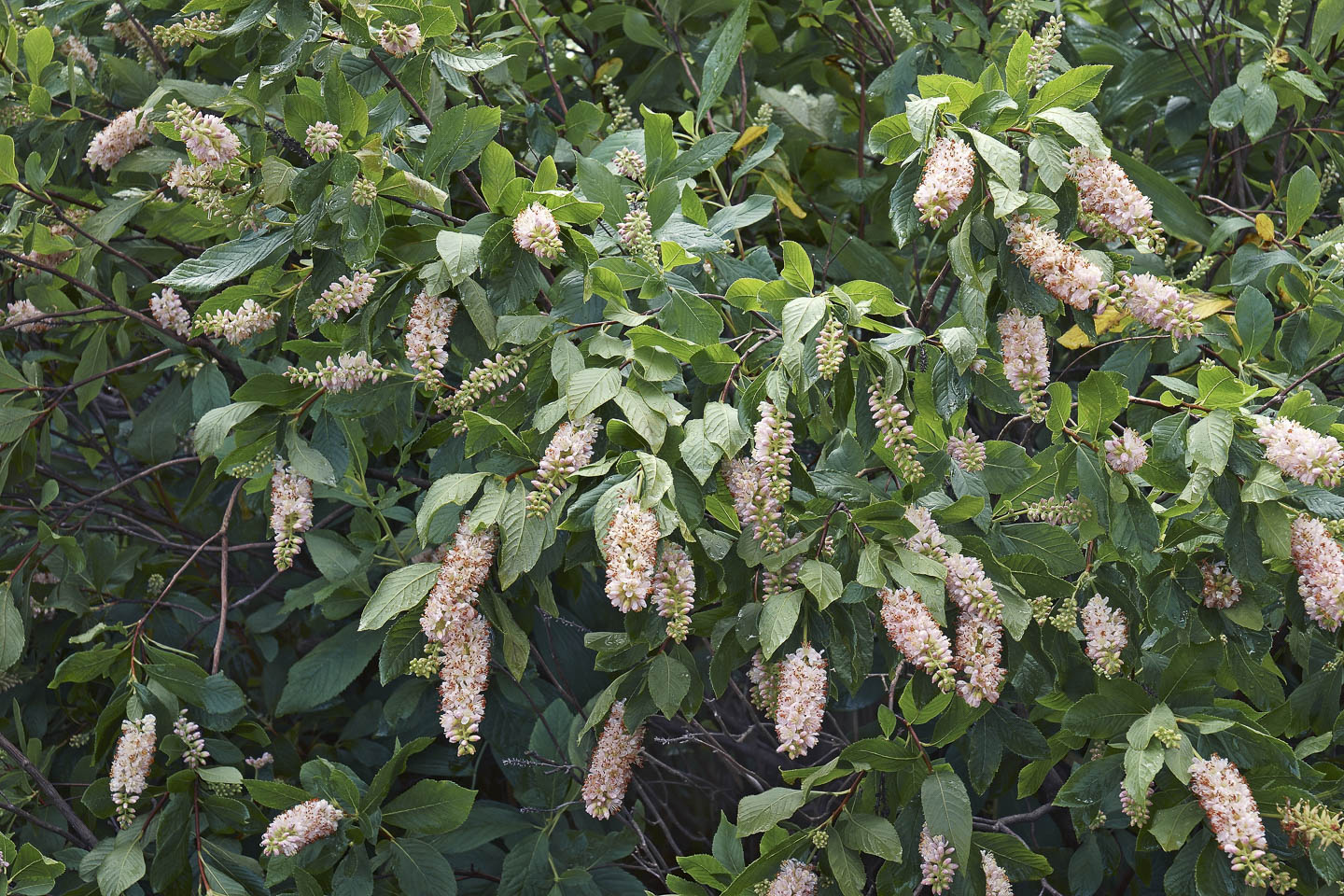
As the name implies, summersweet produces flowers in the summer that have a beautiful perfume.
And it has fall interest because the leaves turn a spectacular yellow to orange color.
Clethra alnifolia also prefers moist to wet soil that is slightly acidic.
It is a native plant and can look a little wild and unruly. If you want one that's more controlled, try the following variety from Proven Winners.
Sugartina® ‘Crystalina' Summersweet (Clethra alnifolia)
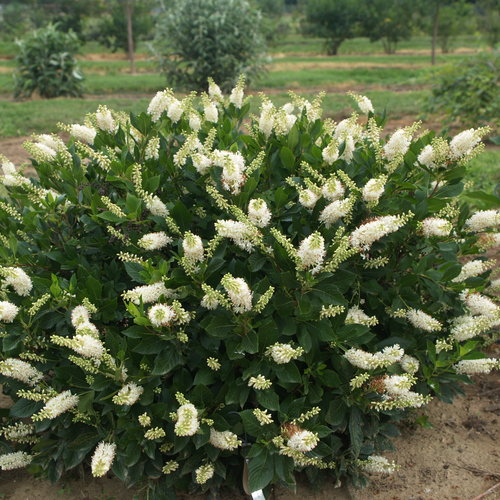
Zone: 4 to 9
Exposure: part shade to sun
Height: 3′
Width: 2′ to 3′
Bloom time: mid-summer
Bloom color: white
Stunning white, fragrant spires rise above very dark green foliage in mid-summer on this easy to grow native dwarf summersweet.
This plant will tolerate some shade and damp soils in a woodland setting.
It is perfect if you want to attract butterflies and repel deer.
The plant holds its dense mounded shape well and doesn't need pruning.
That's it for my list of flowering hedge plants. I hope you have found inspiration for some bushes that will look gorgeous in your yard.
Other gardening ideas you might like
Have comments or questions on our flowering hedge plants? Tell us in the section below.
This post was originally published on September 9, 2021 but was updated with new content on November 23, 2024.















My hydrangeas have not done well at all this summer. The flowers turned a brown color and never went to the large flower of blues and pinks that I normally have.
What could be the reason and how can I prevent this next year?? STUMPED IN NORTH CAROLINA
Hi Peggy…Hydrangea flowers usually turn brown because of not enough water (although it can occasionally occur because of too much water). In either case, making sure that the soil is consistently damp but not soaking wet should help.
Thanks for your reply. They are spent for this season but next year I will pay close attention to the soil……also……I just purchased some cut grocery store hydrangeas (Limelight) I did not use the preserver that came with, I just put them in water. I am going to see if they will root. Wish me luck!
You’ll have to let me know if that works 🙂 Good luck!
Thank you for the information on the different flowering hedge plants. I did not find mine among these and was hoping to identify it. It looks like the kind of hedge you often see that is squared up and runs the length of one’s yard. My yard is somewhat shaded so it has never leafed out or looked like much when I tried to shape it; and when it starts getting tall and gangly I chop it down to a foot or 2 above ground. But this year, since I was unable to do that last summer, I has bloomed beautifully with lots of white sweet smelling blossoms on single stems. I was so surprised. Now i am wondering if I should trim it back after the blooms have all died or would that ruin next year’s blooms?
Hi Carolyn…I’m not sure what type of hedge it is (maybe Gardenia?), but it is usually safe to prune plants right after they have finished blooming. They won’t have had time to set the buds for next year (if it is the type that does that). The only caveat would be if the weather is really hot, I wouldn’t prune it too heavily or it may have trouble recovering.